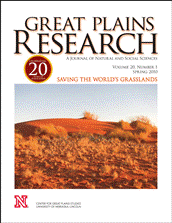Great Plains Studies, Center for
Date of this Version
Fall 1999
Abstract
Explorers and colonists in the American grasslands viewed the landscape as barren and its people as savage. Both the land and its people needed to be controlled, and this often led to the destruction of both the environment and its inhabitants. Our perception of the landscape influences our actions toward it. As we redefine our perception of the landscape, we act differently toward it. We have begun to appreciate the important ecological functions provided by prairie grasslands. Understanding all the resources in plains communities - the human, social, financial and environmental forms of capital - and the impact of each of these types of resources on the others should allow resilience to change and movement toward a more sustainable future, one that balances people and place in the grasslands.


Comments
Published in Great Plains Research 9 (Fall 1999): 397-419. Copyright © 1999 The Center for Great Plains Studies, University of Nebraska–Lincoln. Used by permission. http://www.unl.edu/plains/publications/GPR/gpr.shtml